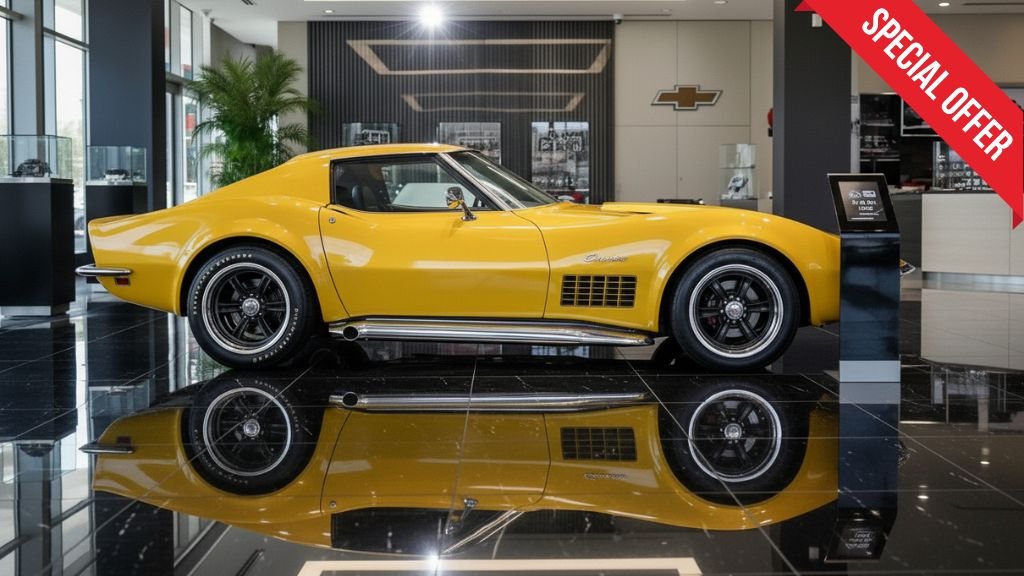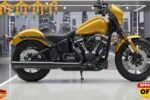1969 Corvette L88: There are muscle cars, and then there is the 1969 Corvette L88—the car that treated a public road like a green flag and a gas pedal like a solemn promise. Even today the phrase 1969 Corvette L88 can send a chill down an enthusiast’s spine because it represents the most unapologetic version of speed: big displacement, racing hardware, and a factory that practically nudged you toward a pit lane.
Where rivals bragged, the Corvette L88 simply arrived, growled, and went to work. What makes it special isn’t just raw pace; it’s the attitude. It is a machine built with lap times in mind, sold to civilians who were expected to know what to do with it.
Why The L88 Was Rated Low And Ran High
One of the most delicious contradictions in American performance history is the L88’s power rating. Officially, the 1969 Corvette was “430 horsepower.” In period, everyone winked. The solid-lifter cam, radical compression, and high-flow heads didn’t whisper 430—they shouted far more, especially with open headers and race fuel.
Chevrolet underrated it to discourage casual buyers and keep the 1969 Corvette in the hands of serious drivers and teams. The result was a showroom car with a paperwork halo and a racetrack soul, capable of humiliating anything that lined up next to it.
Built For Tracks
The 1969 Corvette L88 was conceived as a weapon. Air conditioning was off the table. Radios and excessive insulation were avoided. Everything that didn’t help the stopwatch was treated as ballast. The heavy-duty cooling was there to survive long, hot stints.
The transistor ignition was about stability at high rpm, not creature comfort. Even the gearing felt like a handshake from a crew chief. The 1969 Corvette L88 was a machine that made sense at 7,000 rpm, on slicks, with a timing tower in the background and brake dust on its wheels.
A Shape Carved
The late-sixties Stingray shell remains one of the most dramatic silhouettes ever drawn. Long nose, coke-bottle hips, fastback roofline, and those feral fender peaks that seem to watch the road for you. On the 1969 Corvette L88, that beauty gained purpose.
Functional cowl induction helped the big-block breathe. The chassis squat under throttle wasn’t a flaw; it was theatre. Slip into the driver’s seat and the view over the sculpted hood feels like looking down a rifle barrel. This is the visual poetry of the 1969 Corvette L88—every line a promise of velocity.
Inside
Open the door and you don’t find luxury. You find intent. Big, legible gauges. A steering wheel with the right thickness. A shifter that moves like a bolt-action. On many 1969 Corvette L88 builds, weight-adding options were simply left off the order sheet.
What you hear is mechanical life: the click of solid lifters at idle, the whirr of fuel and fire, the slam of a clutch that expects commitment. It isn’t plush, but it is perfect for what the 1969 Corvette L88 was born to do—go hard, go long, and come back wanting more.
The 427 That Made Legends
Displacement alone doesn’t create lore; components do. The 1969 Corvette L88 used high-flow aluminum heads, a racing cam profile, a giant Holley carb, and a sky-high compression ratio that demanded premium fuel with octane worthy of a pit lane. The payoff was ferocious response.
Crack the throttle and the engine doesn’t rise—it lunges. Mid-range torque is a tidal wave that doesn’t ebb until deep into the rev range. In period trim, the 1969 Corvette L88 could obliterate quarter miles and shame European exotics on long straights. Tuned right, it turned long tracks into personal playgrounds.
Steering, Brakes
A fast car is only as good as its conversation with the driver. The 1969 Corvette L88 spoke in urgent but intelligible sentences. The heavy-duty suspension gave it the muscle to survive curbs and heat cycles, while quick-ratio steering let you square your shoulders into a corner with confidence.
Power front discs took the fear out of late-braking moves. The car’s balance rewarded patience on entry and a decisive right foot on exit. Learn the rhythm, and the 1969 Corvette L88 rewarded you with laps that felt less like work and more like magic.
Cooling
Every racer knows that horsepower without cooling is a short story. The 1969 Corvette L88 arrived with a bigger radiator and the kind of airflow thinking that gave it endurance. Long summer days at the strip, stop-and-go traffic on the way home, then a road course the next morning—this was a routine many owners remember.
The engine’s iron heart ran hot, yes, but it ran honest. Keep the fluids right, give it air, and the 1969 Corvette L88 would give you speed whenever you called.
Soundtrack Of A Thousand Posters
At idle, an L88 doesn’t purr; it glares. The lope is unmistakable, a mechanical metronome that hints at cam overlap and intent. Roll into throttle and the exhaust note rises through layers: bass growl, baritone bellow, metallic snarl. Tunnels aren’t structures; they’re instruments.
Nothing about the 1969 Corvette L88’s sound is polite, and that’s the point. It announces itself with a score that lingers long after you’ve parked and turned the key.
Racing Pedigree
The L88 program existed so Chevrolet loyalists could win. Homologation is a big word for a simple idea: build enough street cars so the race versions are legal. Teams took the 1969 Corvette L88 to venues where lap records were made, not imagined.
It earned trophies, yes, but it also earned something harder to quantify: fear from rivals and respect from anyone who strapped in. Every time a 1969 Corvette L88 rolled off a trailer, the pit lane got a little quieter.
Rarity
Scarcity is part of the romance. Not many were built, fewer survive exactly as specced, and every correct detail—heads, intake, code, stampings—turns up the heartbeat of collectors. Prices reflect that fever. But the 1969 Corvette L88 isn’t just an appreciating asset; it is a living archive.
Owners treat documents like heirlooms and treat the throttle like a sacred switch. The chase for an authentic 1969 Corvette L88 is as intense as the car itself.
Why The L88 Still Matters In 2025 And Beyond
We live in a world of twin-turbo algorithms and EV torque that pins you to the seat in silence. And still, the 1969 Corvette L88 commands attention. Why? Because it offers a raw, analog connection that modern speed often polishes away.
The 1969 Corvette L88 asks you to bring skill, patience, and a little bravery. In return, it hands you memories that feel etched into your bones. That trade will always make sense to people who love driving for what it makes them feel, not just for what it lets them post.
Living With A Legend
Daily driving a 1969 Corvette L88 is like daily wearing a championship ring. It isn’t subtle. The clutch is heavy, the idle is rowdy, the cabin can be hot, and the fuel stops are frequent. But owners don’t complain; they grin. They talk about early-morning runs when the world is cool and quiet, about second gear like a secret
handshake, about the way strangers ask questions at every petrol station. A 1969 Corvette L88 doesn’t blend in, but it does belong—anywhere speed is respected.
The India Today / NDTV-Style Takeaway
If you strip away the myths and judge it as a car, the verdict remains the same: the 1969 Corvette L88 is outrageously fast, surprisingly communicative, and purpose-built to turn drivers into believers. It’s not practical, it’s not polite, and it absolutely doesn’t care.
That’s exactly why it’s irresistible. In an era where so much is curated and calculated, the 1969 Corvette L88 is gloriously unfiltered. One start, one sweep to redline, and you understand why it still rules conversations more than half a century later.
Specs Spotlight
Under the hood sat aluminum heads that breathed like athletes, a cam profile that turned idle into a swagger, and a carb that gulped air like a storm. The compression ratio meant high-octane only, a requirement that quietly separated tourists from true believers.
The heavy-duty four-speed didn’t baby anyone; it asked for a decisive hand. Positraction got power to the ground instead of smearing it into smoke—unless, of course, you asked it to. The 1969 Corvette L88 combined these bits into a package that felt race-ready the moment you slid the shifter into first.
On A Back Road
Pick your playground. On a back road, the car rewards patience and a tidy line, then slingshots you out of corners on a wave of torque. On a drag strip, the 1969 Corvette L88 treats Christmas Tree lights like starting pistols, stacking gears with the inevitability of a freight train.
On a circuit, slicks, pads, and cooling transform it from wild to wickedly precise. The same DNA adapts, the same attitude prevails. You can dress the 1969 Corvette L88 for any arena, and it will speak the local language fluently: faster.
The Human Element
Machines this intense create rituals. Owners warm the engine, listen to the idle settle, and choose roads with long sightlines.
They talk about tire compounds the way chefs talk about salt. They tune carbs by ear, read plugs like tea leaves, and keep a toolbox that smells like race day. The 1969 Corvette L88 makes drivers better because it demands focus, and the reward is a kind of clarity that lingers long after the drive ends.
Value Beyond Money
Yes, values have soared. But the 1969 Corvette L88’s worth can’t be locked in a spreadsheet. It lives in fathers explaining fender badges to kids, in late-night stories that start with “You should have heard it,” in friendships forged trackside under a pop-up tent.
The car is a community, a culture, and a piece of history that still makes new history every time it fires.
Final Verdict
If you want to know why the 1969 Corvette L88 still sits at the head of the table, stand behind one when it blips the throttle. Feel the ground hum, the chest thump, the hair rise.
Then watch it leave, straight and absolute. In that moment the decades fold away. Numbers can try, but they can’t capture that sensation. The 1969 Corvette L88 is proof that some machines aren’t just built; they’re born. And this one was born fast.
Frequently Asked Questions
Why was the 1969 Corvette L88 underrated at 430 horsepower
The 1969 Corvette L88 carried a conservative number to keep casual buyers at bay and to suit insurance realities. In race-ready trim, output was substantially higher, which is why the 1969 Corvette L88 stunned rivals whenever real timing equipment was involved.
Is the 1969 Corvette L88 difficult to live with in modern traffic
It demands respect. The clutch is firm, the idle is assertive, and the heat management expects movement. But owners of a 1969 Corvette L88 accept these traits because the payoff—sound, response, and drama—is irreplaceable.
How rare is an authentic 1969 Corvette L88
It is exceptionally rare, with limited production and many cars modified or lost over time. Documented components and correct codes are crucial. That scarcity is a major reason the 1969 Corvette L88 commands such reverence.
What makes the 1969 Corvette L88 different from other big-block Corvettes
The parts list. Aluminum heads, serious compression, specific cam and induction, heavy-duty cooling, and race-centric deletes made the 1969 Corvette L88 a focused tool rather than a fast cruiser. It feels sharper and more purposeful than its peers.
Is the 1969 Corvette L88 still competitive in classic events
Absolutely. In historic racing and well-run drag events, a sorted 1969 Corvette L88 remains a handful for anything with period-correct credentials. Its combination of torque, gearing, and cooling keeps it dangerous long after the green flag drops.
Does the 1969 Corvette L88 have any comfort features at all
Basic amenities exist, but the focus is performance. Many examples skipped radios and air conditioning entirely. The 1969 Corvette L88 is about connection, not convenience, and that clarity is part of its charm.
What fuel does the 1969 Corvette L88 require
High-octane fuel is mandatory because of the compression ratio and timing demands. Owners of the 1969 Corvette L88 often plan routes and tuning around fuel quality to keep the big-block happy and healthy.
How does the 1969 Corvette L88 compare to modern performance cars
Modern tech delivers outrageous numbers, but the 1969 Corvette L88 offers something rarer: unfiltered sensation. Steering feedback, manual shifts, mechanical music—these make the 1969 Corvette L88 thrilling in a way spec sheets can’t explain.
Why is the 1969 Corvette L88 so desirable to collectors
It blends rarity, racing pedigree, and an unmatched presence. A real 1969 Corvette L88 represents the most serious expression of late-sixties American performance, and that combination of authenticity and attitude is priceless.
What’s the single best reason it remains a legend
One drive answers the question. The 1969 Corvette L88 turns distance into drama and seconds into stories. It doesn’t just go fast; it makes you feel fast. That’s the heart of the legend, and it isn’t going anywhere.



